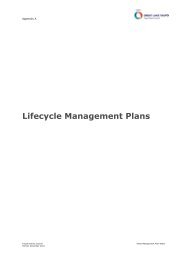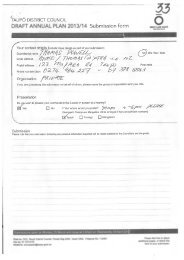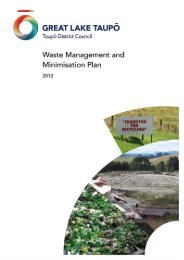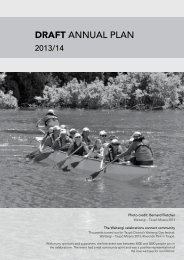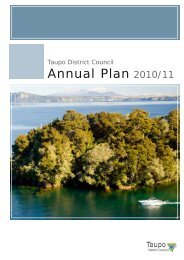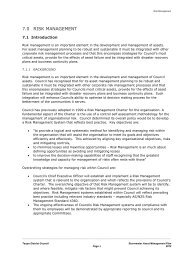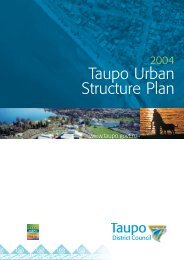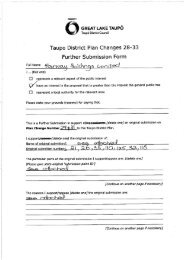Geotechnical Assessment - Taupo District Council
Geotechnical Assessment - Taupo District Council
Geotechnical Assessment - Taupo District Council
You also want an ePaper? Increase the reach of your titles
YUMPU automatically turns print PDFs into web optimized ePapers that Google loves.
The occurrence of tomos created by piping is often unpredictable. <strong>Taupo</strong> Pumice is<br />
present beneath all of the areas studied and is usually underlain by a paleosol. The<br />
paleosol is undulatory which may control the direction of ground water flow. There is<br />
potential for tomos to form under all of the proposed industrial sites, but there are a<br />
number of areas in which their probability is high. Areas which contain deeply incised<br />
gully systems, for example, are likely to be more susceptible to piping induced tomos.<br />
Such systems are present in areas 4, 7 and 8 and to the north of Area 10. Tomos and<br />
irregular ground were observed in areas 4, 7 and 8 during the site walkover.<br />
Geothermal ground conditions are present beneath a number of the sites visited. The<br />
geothermal areas have been highlighted as high risk of tomo formation. This risk is well<br />
illustrated in the contours for the southern part of Area 6. The ground surface adjacent to<br />
Raywood Crescent is highly irregular as is characteristic of geothermal areas. This<br />
irregular surface extended beneath Raywood Crescent and Claret Ash Drive prior to<br />
industrial development. Steam vents installed adjacent to Raywood Crescent indicate<br />
that the geothermal field is still active in this area. Other areas at risk from geothermally<br />
induced tomos include 3, 4 and 5.<br />
<br />
<br />
Landslides are induced through excess porewater pressures and oversteepened slopes.<br />
They may also be caused by human activities where excavations create excessively steep<br />
or high slopes and where construction imparts excessive loads on nearby slopes.<br />
No groundwater seepages were observed during the walkover and the water table is<br />
generally quite deep suggesting excess porewater pressures do not occur in the study<br />
area. In addition most of the proposed industrial areas are either flat or undulating and<br />
landsliding is not perceived to be a major problem. Landsliding may be an issue,<br />
however, on steep slopes in areas with incised gully systems, particularly during<br />
earthquakes. Landsliding may also be an issue on the southern slopes of a buried lava<br />
dome in Area 4, especially if the slope is excavated during development.<br />
Locations that have a landslide hazard are located in areas 4, 5, 7, 8 and 10. Landsliding<br />
issues may also be associated with some less incised gullies, but they are unlikely to be<br />
large scale. Some set back should be maintained from any incised gully systems<br />
<br />
<br />
<br />
<br />
Regional subsidence has been examined by Contact Energy 10 . It is associated with<br />
pressure decline in the geothermal system due to the extraction of geothermal fluids for<br />
electricity generation. The Tauhara Geothermal Field underlies the north and east of the<br />
<strong>Taupo</strong> Township and is hydrologically linked with the Wairakei Geothermal Field. Fluid<br />
flow from the Tauhara Geothermal Field to the Wairakei field has lead to subsidence in<br />
these areas. It has also lead to the generation of shallow steam zones and further hot<br />
ground in the Tauhara Geothermal Field.<br />
The magnitude and rate of future subsidence will be dependent on the extraction rates of<br />
geothermal fluids from Wairakei and Tauhara geothermal fields. Subsidence rates of<br />
between 0 and 45 mm/year have been calculated in the study area. The greatest<br />
10 Contact Energy (2007) Ground level change study.



